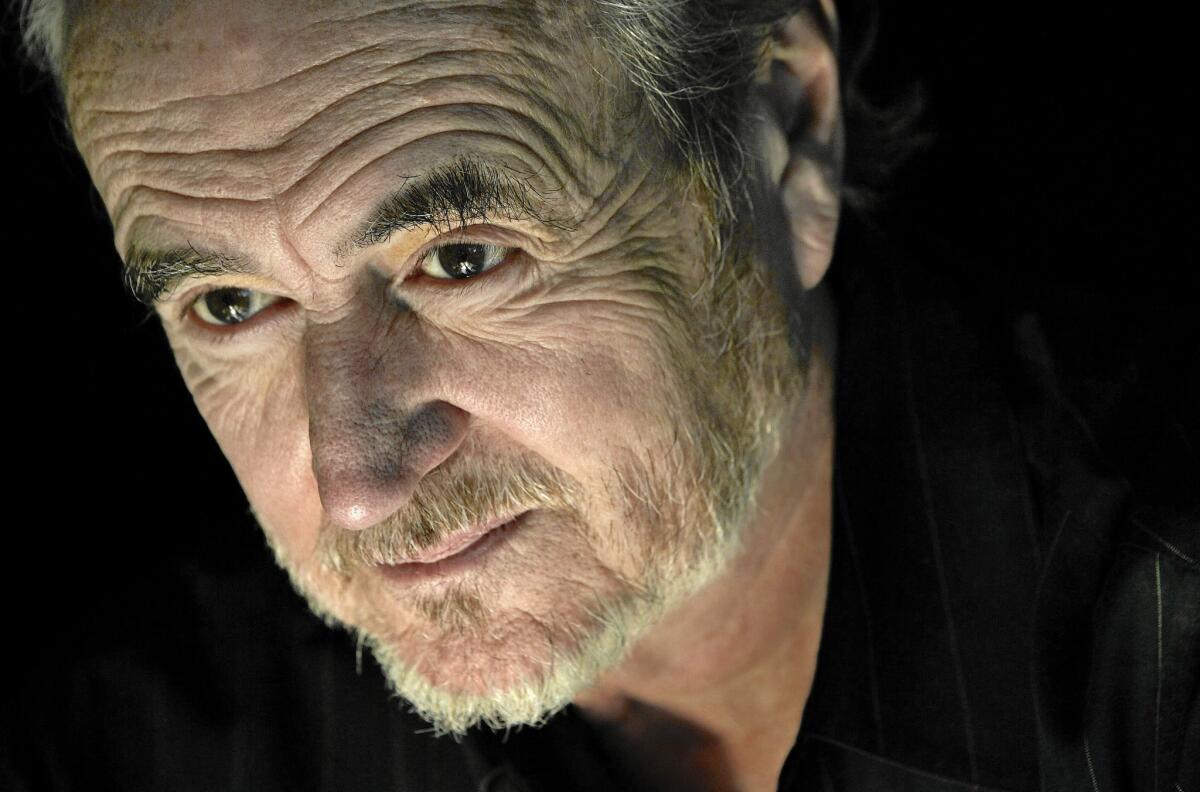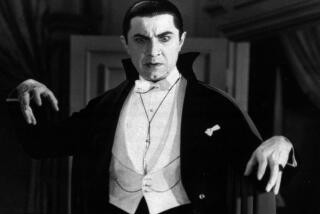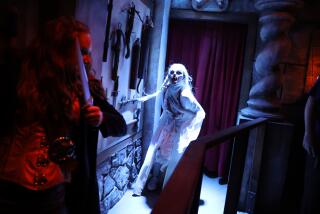Wes Craven dies at 76; prolific director behind ‘A Nightmare on Elm Street’ and ‘Scream’ horror films

Wes Craven at his home in 2009. Toward the end of his more than four-decade career, which included forays as a television producer and novelist, the master of the horror genre made peace with his fearsome reputation.
Wes Craven, the prolific filmmaker behind “A Nightmare on Elm Street” and the “Scream” movies, kicked off his career with a film so violent and gory, censors in Britain banned it from theaters. He followed that by creating Freddy Krueger, an unhinged character who still terrorizes audiences.
But the director long wanted to break free from the horror genre he defined, so when producers Bob and Harvey Weinstein approached him with a three-picture deal, they sweetened the offer by letting him direct 1999’s “Music of the Heart,” the uplifting story of an East Harlem violin teacher who brings music to scores of underprivileged students. It starred Meryl Streep, earning her an Oscar nomination.
Still, as Alfred Hitchcock’s name came to be synonymous with thrillers and Sergio Leone’s to spaghetti westerns, Wes Craven’s name will forever be linked to horror films. The filmmaker died Sunday at his Los Angeles home after a battle with brain cancer, according to his representative. He was 76.
Toward the end of his more than four-decade career, which included forays as a television producer and novelist, he made peace with his fearsome reputation.
“Sometimes you fight what you are, what you’re doing,” he told ABC News in 2010. “At a certain point you say, you know I’m really good at this and people really seem to enjoy what I do and I’ve definitely left a mark on American cinema of some sort or another.”
Craven created some of the genre’s most influential films, including 1977’s “The Hills Have Eyes,” 1984’s “A Nightmare on Elm Street” and 1996’s “Scream.” He also gave birth to some of its most terrifying images: a suburban family terrorized by a band of savage cannibals, a killer with razor blades for fingers who stalks teenagers in their dreams.
“He was a consummate filmmaker and his body of work will live on forever,” Bob Weinstein, co-chairman of the Weinstein Co. and Dimension Films, said in a statement Sunday night.
Actress Rose McGowan, who co-starred in “Scream,” took to Twitter to call Craven “the kindest man, the gentlest man, and one of the smartest men I’ve known.” Of the day’s news, she added: “Please say there’s a plot twist.”
Contemporary horror filmmaker Jason Blum, chief executive of Blumhouse Productions, said via email: “The horror community suffered a big blow with the passing of Wes Craven. Talk about a true pioneer. All of his movies pushed the genre forward because they had something thoughtful to say, whether it was about the Vietnam War, teenage angst, abuse or class warfare. He gave us movies with meaning and big scares. It is hard to do that once or twice; it’s basically impossible to do it as often as Wes did. He constantly reinvented himself and the genre and left an indelible mark on multiple decades of film and multiple generations of horror fans. Thank you for everything and rest in peace.”
For Craven, making a scary movie was far more than simply a matter of delivering cheap shocks. It was an exercise in societal catharsis, a foray into the audience’s collective unconscious.
“I think the genre goes outside the boundaries of reality in many ways in order to get at some central truths and feelings that aren’t served well by very factual states,” he told The Times in 2010.
“Whether it be psychotic behavior or being possessed or being in a killing rage, whatever it is, these are things that are not part of our rational grid.... Those things are primordial to the human species, the double curse of being aware of your own existence and being kind of alone in it. Genre films go to those areas, because we’re talking about very raw human feelings and perceptions.”
Craven was born in Cleveland on Aug. 2, 1939, and raised by strict Baptist parents who forbade him from watching movies. Earning a master’s degree in philosophy and writing from Johns Hopkins University, he seemed destined for a quiet life in academia. But while working as a humanities professor at Clarkson University in Potsdam, N.Y., Craven fell in love with film at the local art house theater and his life took a dramatic turn.
Radically shifting gears, Craven entered the film business, where he soon found himself writing and directing pornographic films under pseudonyms. Even as he made the transition to the somewhat more respectable horror genre, he maintained his appetite for pushing the boundaries of what was considered acceptable, even — or perhaps especially — if it meant inciting controversy.
Shot for just $90,000, “The Last House on the Left” — the story of two teenage girls who are taken into the woods and tortured by a violent gang — was censored in many countries for its extreme sadism and violence. The film earned generally favorable reviews from critics, however, with Roger Ebert calling it “about four times as good as you’d expect.”
“I didn’t know a thing about directing,” Craven told The Times in 2010. “I staged it like a documentary because the year or two I learned the basics of film, I worked in a building that had mostly documentary filmmakers.”
With “A Nightmare on Elm Street,” Craven delivered his biggest hit to date and created one of the genre’s most indelible villains: Freddy Krueger, a hideously scarred serial killer who wears a glove armed with razor blades and stalks his teenage victims in their dreams. The film earned $25 million at the box office, spawning a franchise and numerous imitators.
“A Nightmare on Elm Street” demonstrated Craven’s penchant for toying with the conventions of the horror genre — a characteristic he would bring to its fullest fruition in his 1996 smash “Scream.”
The tale of a high school student who becomes the target of a mysterious killer known as Ghostface, “Scream” played with audience’s expectations at every turn with winking humor while still delivering genuine scares. Grossing $173 million worldwide, the film spawned a franchise and was credited with revitalizing the horror genre, inspiring other cheekily self-aware horror films to follow such as “Shaun of the Dead” and “The Cabin in the Woods.”
Craven went on to direct three more “Scream” films, along with the well-received 2005 psychological thriller “Red Eye,” which centered on a terrorist assassination plot on a red-eye flight.
Driven by an unceasing appetite for work, Craven remained busy until the end of his life. He had recently been developing a number of television projects, including “The People Under the Stairs” with Syfy, and was executive producing a new “Scream” series for MTV.
For Craven — survived by his wife Iya Labunka, sister Carol Buhrow, son Jonathan Craven, daughter Jessica Craven, stepdaughter Nina Tarnawksy and three grandchildren — the appeal of scaring a group of strangers witless never lost its appeal.
“When I go to the theater to see the audience they come out of the movie laughing, like people coming off a roller coaster,” he told The Times in 2007. “Some people ask why people would go into a dark room to be scared. I say they are already scared and they need to have that fear manipulated and massaged. I think of horror movies as the disturbed dreams of a society.”
Times staff writers Matt Hamilton, Meredith Woerner and Lauren Raab contributed to this report.
More to Read
Start your day right
Sign up for Essential California for the L.A. Times biggest news, features and recommendations in your inbox six days a week.
You may occasionally receive promotional content from the Los Angeles Times.







